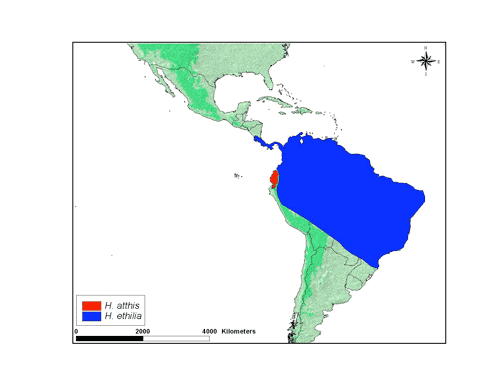Heliconius atthis
Margarita BeltránIntroduction
Etymology: Attis or Atys, in the Phrygian religion (in Anatolia in present day Turkey), was the vegetation god. When Nana ate the fruit of the almond tree, which had been generated by the blood of either Agdistis or of Cybele, she conceived Attis. Later, Agdistis or Cybele fell in love with Attis, and so that neither would have him, she caused him to castrate himself. Like Adonis, Attis came to be worshiped as a god of vegetation, responsible for the death and rebirth of plant life. Each year at the beginning of spring his resurrection was celebrated in a festival. In Roman religion he became a powerful celestial deity (Attis).
Characteristics
Early stages: Eggs are yellow and approximately 1.3 x 0.8 mm (h x w). Females usually place eggs singly on growing shoots and tendrils of the host plant. Mature larvae have a white body with black scoli, and orange head; length is around 1.5 cm. Caterpillars are gregarious in small numbers (Brown, 1981).
Geographical Distribution
Heliconius atthis is distributed in West Ecuador. The map below shows an approximate representation of the geographic distribution of this species. The original data used to draw these maps are derived from Brown (1979) which is available at Keith S. Brown Jr. (1979). Ecological Geography and Evolution in Neotropical Forests.
Habits
H. atthis occurs from sea level to 1,900 m in marginal forests. Usually individuals fly slowly and in the lowerstory. Females mate multiply on hill tops, and adults roost solitarily or in loose groups at night at 2-10 m above ground on twigs or tendrils.
Hostplant: H. atthis larvae feed primarily on plants from the genus Passiflora from the subgenera Granadilla section Quadrangulares, Digitales, and Laurifoliae, notably Passiflora subpeltata (Brown, 1981).
References
Atthis. HighBeam Encyclopedia. http://www.encyclopedia.com/doc/1E1-Attis.html [Accessed July 16, 2008].
Brown K. S. 1981 The Biology of Heliconius and Related Genera. Annual Review of Entomology 26, 427-456.
Doubleday E. 1847 The genera of diurnal Lepidoptera: comprising their generic characters, a notice of their habits and transformations, and a catalogue of the species of each genus. London, Longman, Brown, Green & Longmans. 1: 87-98, pls. 16-17 (9 July 1847), 99-106, pls. 18-19 (4 August 1847), 107-110, pls. 18*, 20 (1 September 1847), 111-118, pls. 21, 23 (4 October 1847), 119-124, pls. 22, 24 (2 November 1847), 125-132, pls. 25, 28 (2 December 1847), 133-136 (7 January 1848), 137-138 (3 February 1848).
About This Page
Margarita Beltrán

University of Cambridge, Cambridge, UK
Correspondence regarding this page should be directed to Margarita Beltrán at
beltran.margarita@gmail.com
Page copyright © 2010 Margarita Beltrán
 Page: Tree of Life
Heliconius atthis .
Authored by
Margarita Beltrán.
The TEXT of this page is licensed under the
Creative Commons Attribution-NonCommercial-ShareAlike License - Version 3.0. Note that images and other media
featured on this page are each governed by their own license, and they may or may not be available
for reuse. Click on an image or a media link to access the media data window, which provides the
relevant licensing information. For the general terms and conditions of ToL material reuse and
redistribution, please see the Tree of Life Copyright
Policies.
Page: Tree of Life
Heliconius atthis .
Authored by
Margarita Beltrán.
The TEXT of this page is licensed under the
Creative Commons Attribution-NonCommercial-ShareAlike License - Version 3.0. Note that images and other media
featured on this page are each governed by their own license, and they may or may not be available
for reuse. Click on an image or a media link to access the media data window, which provides the
relevant licensing information. For the general terms and conditions of ToL material reuse and
redistribution, please see the Tree of Life Copyright
Policies.
- First online 18 February 2007
- Content changed 12 August 2008
Citing this page:
Beltrán, Margarita. 2008. Heliconius atthis . Version 12 August 2008 (under construction). http://tolweb.org/Heliconius_atthis/72905/2008.08.12 in The Tree of Life Web Project, http://tolweb.org/








 Go to quick links
Go to quick search
Go to navigation for this section of the ToL site
Go to detailed links for the ToL site
Go to quick links
Go to quick search
Go to navigation for this section of the ToL site
Go to detailed links for the ToL site